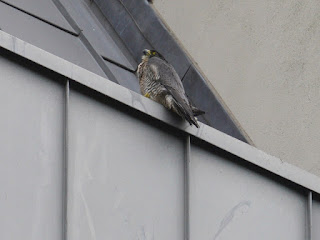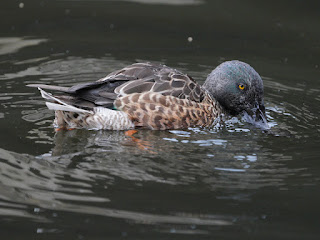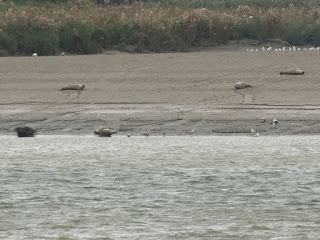A Carrion Crow ate a Feral Pigeon killed by a raptor on the grass below the Knightsbridge Barracks tower. The scattered feathers show that the killer was a Sparrowhawk, probably a male as they are too small to carry pigeons and have to eat them on the spot, from which they are easily frightened off.
The male Peregrine looked down from the tower without much interest. Any time he feels hungry he can catch a pigeon from the mob on the grass.
The original pigeon-eating Lesser Black-Backed Gull wandered through a crowd of Feral Pigeons and had a go at one, but it got away leaving him with only a feather.
A teenage Blackbird looked for insects in the wood chips under the Caucasian Elm in the Rose Garden. He is beginning to get his adult black feathers.
A Mistle Thrush ate rowan fruit on Buck Hill.
A flock of Long-Tailed Tits passed through the willows on the south shore of the Serpentine.
A Grey Heron fished in the little stream in the Dell.
The two youngest Great Crested Grebe chicks on the Long Water are growing fast. Each follows one parent.
There were 20 Shovellers in the park today, 18 of them on the Long Water ...
... and two on the Serpentine.
Honeybees are still hard at work on the Autumn Oxeye daisies in the Rose Garden.
A new crop of Shaggy Parasol mushrooms has come up at the northwest corner of the bridge ...
... and there was this mushroom, about 3 inches across, under a linden tree near the Serpentine Gallery. As usual, I don't know what it is. Update: Mario says it is probably a Russula species, maybe R fragilis. But see his cautious comment below.
Jim was asking me about parish boundary markers. Three parishes meet in the Italian Garden: St George's Hanover Square to the east, Paddington to the north, and Marylebone to the northeast. Not shown here is a boundary marker for St Mary Abbots church to the west, but there are several of these elsewhere in Kensington Gardens.
Tom was at Rainham Marshes, and got a picture of five Common Seals on the mud at the opposite side of the river.










The mushroom is a Russula (brittlegill), possibly Russula fragilis. But in the UK there are at least 200 species. To identify a Russula to a species usually you need smell, taste and application of chemicals, and then microscopy. The colour of the cap is just a pointer, as it is water-soluble, so it easily fades away.
ReplyDeleteMany thanks. Even in the challenging field of mycology this seems a difficult case.
DeleteIt always surprises me how pigeons take Pigeon Killer's vicinity in their stride. He is a killing machine and not to be taken lightly. That pigeon got lucky.
ReplyDeleteI love the video of the Shovellers revolving. I get a bit dizzy afterwards, but it's worth it!
The parallel that occurs to me after seeing those pigeons allowing themselves to be stalked is the image well known from African wildlife documentaries of antelopes calmly drinking at a waterhole with a lion among them. Or possibly of most of the population of the western world slumped in front of a trivial television show as a deranged government does its utmost to destroy them.
Delete